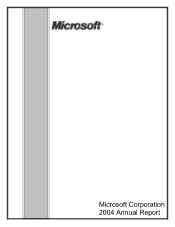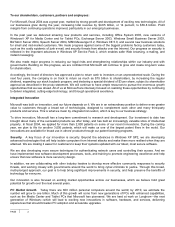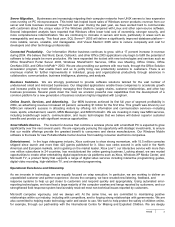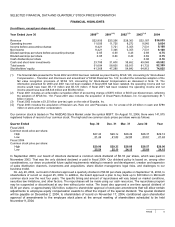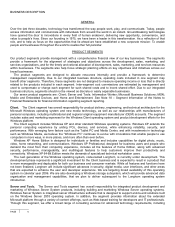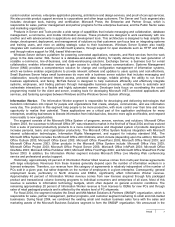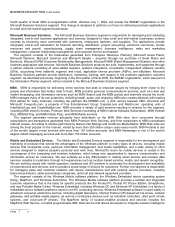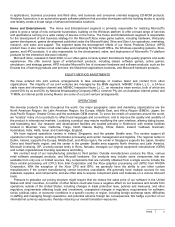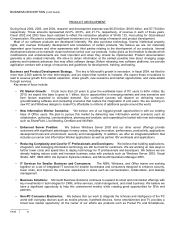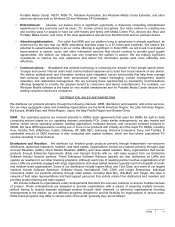Microsoft 2004 Annual Report Download - page 7
Download and view the complete annual report
Please find page 7 of the 2004 Microsoft annual report below. You can navigate through the pages in the report by either clicking on the pages listed below, or by using the keyword search tool below to find specific information within the annual report.
PAGE 7
custom solution services, enterprise application planning, architecture and design services, and proof-of-concept services.
We also provide product support services to corporations and other large customers. The Server and Tools segment also
includes: developer tools, training, and certification; Microsoft Press; the Enterprise and Partner Group, which is
responsible for sales, partner management and partner programs for the enterprise business; and the Public Sector sales
and marketing organization.
Products in Server and Tools provide a wide range of capabilities that include messaging and collaboration, database
management, e-commerce, and mobile information access. These products are designed to work seamlessly with one
another and with advancements in applications and development tools. This architecture is designed to help simplify the
design, development, deployment, and management of solutions so that customers can focus less on integrating systems
and training users, and more on adding strategic value to their businesses. Windows Server System also readily
integrates with customers’ existing non-Microsoft systems, through support for open standards such as HTTP and XML,
and through native support for XML-based Web services.
Windows Server delivers a platform for powering connected applications, networks, and Web services from the work
group to the data center. SQL Server is a database-and-analysis offering for rapidly delivering the next generation of
scalable e-commerce, line-of-business, and data-warehousing solutions. Exchange Server, a business tool for e-mail
collaboration, enables information workers to gain access to critical business communications. Systems Management
Server (SMS) provides a comprehensive solution for change and configuration management of information systems,
which we believe enables organizations to provide relevant software and updates to users quickly and cost-effectively.
Small Business Server helps small businesses do more with a business server solution that includes messaging and
collaboration, security-enhanced Internet access, protected data storage, reliable printing, the ability to run line-of-
business applications, and faxing. BizTalk Server is designed to help customers efficiently and effectively integrate
systems, employees, and trading partners through manageable business processes, enabling them to automate and
orchestrate interactions in a flexible and highly automated manner. Developer tools focus on coordinating the overall
programming model for the client and server, creating tools for developing Microsoft .NET-connected applications and
services, and fostering synergies between Windows and the Windows Server System offerings.
Information Worker. The Information Worker segment is responsible for developing and delivering technologies that
transform information into impact for people and organizations that create, analyze, communicate, and use information
every day. The products in this segment help people to be more productive, with more control over their time and more
opportunity to realize their potential. These applications are a critical part of the application architecture for many
enterprises, enabling businesses to liberate information from individual silos, become more agile and flexible, and respond
more readily to new opportunities.
The segment consists of the Microsoft Office System of programs, servers, services, and solutions. Microsoft Office
System 2003, the successor to Microsoft Office XP, was released to market in the first half of fiscal 2004 and has evolved
from a suite of personal productivity products to a more comprehensive and integrated system of products designed to
increase personal, team, and organization productivity. The Microsoft Office System features integration with Microsoft
intranet collaboration technologies, Information Rights Management, and support for industry standard XML. The
Microsoft Office System includes the Microsoft Office 2003 Editions, which include (depending upon the edition): Microsoft
Office Outlook 2003; Microsoft Office Excel 2003; Microsoft Office PowerPoint 2003; Microsoft Office Word 2003; and
Microsoft Office Access 2003. Other products in the Microsoft Office System include: Microsoft Office Visio 2003;
Microsoft Office Project 2003; Microsoft Office Project Server 2003; Microsoft Office InfoPath 2003; Microsoft Office
OneNote 2003; Microsoft Office Publisher 2003; Microsoft Office FrontPage 2003; and Microsoft Office SharePoint Portal
Server 2003. In addition, the Information Worker segment includes Microsoft Office Live Meeting Web conferencing
service and professional product support.
Historically, approximately 40 percent of Information Worker billed revenue comes from multi-year license agreements
with large enterprises. Revenues from these licenses generally depend upon the number of information workers in a
licensed enterprise. Therefore, our revenue from this category of agreements is relatively independent of the number of
PCs sold in a given year, but rather depends on the number of employees in a given enterprise. Consequently, general
employment levels, particularly in North America and EMEA, significantly affect Information Worker revenue.
Approximately 40 percent of Information Worker revenue comes from new licenses acquired through fully packaged
product and transactional volume licensing programs to individual consumers and enterprises of all sizes. Most of this
revenue is sensitive to information technology budgets, which often depend on general economic conditions. The
remaining approximately 20 percent of Information Worker revenue is from licenses to OEMs for new PCs and through
sales of retail packaged products and is affected by the relative level of PC shipments.
For fiscal 2004, the segment includes the Small and Mid-Market Solutions & Partners (SMS&P) organization, which is
responsible for sales, partner management, partner programs, and customer segment marketing to small and mid-market
businesses. During fiscal 2004, we combined the existing small and medium business sales force with the sales and
marketing assets of the Microsoft Business Solutions segment to form the SMS&P organization. We announced in the

